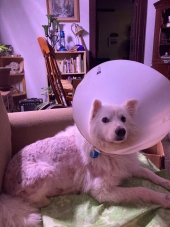
 2
2




Timothy Norton wrote:I'm questioning if some of the chewing is stressed based, she doesn't have separation anxiety per-say but she does have some nervous moments. She is settling in and becoming more comfortable with time and a set daily schedule.
I have obtained some coconut oil and I'm looking into ways to incorporate it in our treatment.
"The only thing...more expensive than education is ignorance."~Ben Franklin. "We can easily forgive a child who is afraid of the dark; the real tragedy of life is when men are afraid of the light." ~ Plato

 4
4




- Tim's Homestead Journal - Purchase a copy of Building a Better World in Your Backyard - Purchase 6 Decks of Permaculture Cards -
- Purchase 12x Decks of Permaculture Cards - Purchase a copy of the SKIP Book - Purchase 12x copies of Building a Better World in your Backyard
 5
5




 2
2




 5
5




 4
4




Maureen Finn wrote:Consider yeast
 4
4




 5
5




Best luck: satisfaction
Greatest curse, greed
 2
2




Thekla McDaniels wrote:Thanks for all the reminders of things I haven’t done for my dog.
Great Pyrenees. A big girl! About 16 months at this point. She started getting something on the tip of her nose. I just thought it was the mud at first, or high elevation sun.
The funny patch spread up the top of her nose towards her eyes. Then she had some funny spots around her eyes. The rate of spread accelerated. By the time I got her to the vet the insides of her ears were inflamed and weeping, and she had patches all over, and between her toes….
It’s a condition called pemphigus. It’s an autoimmune condition. It’s subsided quite a bit, mostly because of the cortisone pills. Prednisone. I hate giving her prednisone, it has dire and extensive side effects. My opinion on prednisone is that it’s only appropriate in life or death situations, but that’s what this is! Without the prednisone I think she would have no hair, no skin, probably be dead by now. I am very gradually decreasing the daily dose. And using quality of life as a guide.
Remarkably she doesn’t appear uncomfortable nor to be suffering a decreased quality of life, has only a small patch on her nose, we’re back to the starting place.
But all these reminders about calendula, plantain probably comfrey, all the skin supporting herbs might feel good and help the skin and hair maintain themselves.
And yes, I give her a “quality” diet but I am sure I could improve it by studying this whole thread intensively!
Thanks so much !
For the curious, it is not advisable to give varying amounts of prednisone, or other corticosteroids. It’s a powerful hormone and tied to our circadian rhythm rhythms. The best possible strategy is a constant dose at a specific time. Our (mammals) cortisone levels are naturally highest in the morning on arising. That’s the time of day I give her dose. In autoimmune conditions you start off with a large enough dose to suppress what ever you want to suppress. Stay at that level to see an improvement, then very carefully, begin to taper off.
I had a friend who years ago had some inexplicable painful skin thing. On prednisone for more than a year . She wanted to get off it. Had to convince the doctor who liked the results of it. But she described to me what the internal experience was to just taper the daily dose by a small percentage…..
My mental picture is that there’s an equilibrium which allows the healing, and the idea is to decrease the dose without upsetting the equilibrium. Then stay at that dose until the body has adjusted to the lower levels of the drug before again reducing it.
The vet said “ sometimes they get over it”. So wish my darling Sharkie all the luck in the world. She’s a YOUNG dog.
 3
3




Best luck: satisfaction
Greatest curse, greed
 5
5




 5
5




 3
3




 3
3




This is very effective if, as you say, there are external parasites (diatomaceous earth also helps with internal parasites) but if the itching stems from an allergic reaction other than that, the DE won't help. but certainly won't hurt. It's vital only to use FOOD grade DE.[/quote wrote:
DE (diatomaceous earth) only works at killing insects/parasites when it's DRY. Once it gets wet, the killing mechanism (the way it pierces the insect body to dehydrate it to death) no longer works.
This link does a great job explaining why that's true.
https://thepoolandlawn.com/what-happens-if-diatomaceous-earth-gets-wet/
Life doesn't always follow the plan.
No, I'm not all-right - I'm half left!

|
Beauty is in the eye of the tiny ad.
Heat Infographic
https://permies.com/w/heat
|







